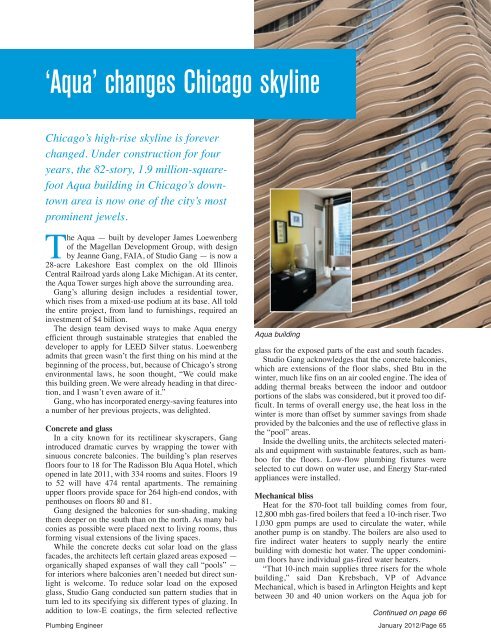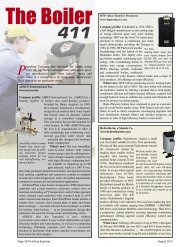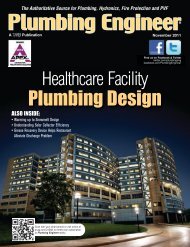open issue - Plumbing Engineer
open issue - Plumbing Engineer
open issue - Plumbing Engineer
You also want an ePaper? Increase the reach of your titles
YUMPU automatically turns print PDFs into web optimized ePapers that Google loves.
pe01_pgs_065_072rev_Layout 1 12/27/11 9:23 AM Page 65<br />
‘Aqua’ changes Chicago skyline<br />
Chicago’s high-rise skyline is forever<br />
changed. Under construction for four<br />
years, the 82-story, 1.9 million-squarefoot<br />
Aqua building in Chicago’s downtown<br />
area is now one of the city’s most<br />
prominent jewels.<br />
The Aqua — built by developer James Loewenberg<br />
of the Magellan Development Group, with design<br />
by Jeanne Gang, FAIA, of Studio Gang — is now a<br />
28-acre Lakeshore East complex on the old Illinois<br />
Central Railroad yards along Lake Michigan. At its center,<br />
the Aqua Tower surges high above the surrounding area.<br />
Gang’s alluring design includes a residential tower,<br />
which rises from a mixed-use podium at its base. All told<br />
the entire project, from land to furnishings, required an<br />
investment of $4 billion.<br />
The design team devised ways to make Aqua energy<br />
efficient through sustainable strategies that enabled the<br />
developer to apply for LEED Silver status. Loewenberg<br />
admits that green wasn’t the first thing on his mind at the<br />
beginning of the process, but, because of Chicago’s strong<br />
environmental laws, he soon thought, “We could make<br />
this building green. We were already heading in that direction,<br />
and I wasn’t even aware of it.”<br />
Gang, who has incorporated energy-saving features into<br />
a number of her previous projects, was delighted.<br />
Concrete and glass<br />
In a city known for its rectilinear skyscrapers, Gang<br />
introduced dramatic curves by wrapping the tower with<br />
sinuous concrete balconies. The building’s plan reserves<br />
floors four to 18 for The Radisson Blu Aqua Hotel, which<br />
<strong>open</strong>ed in late 2011, with 334 rooms and suites. Floors 19<br />
to 52 will have 474 rental apartments. The remaining<br />
upper floors provide space for 264 high-end condos, with<br />
penthouses on floors 80 and 81.<br />
Gang designed the balconies for sun-shading, making<br />
them deeper on the south than on the north. As many balconies<br />
as possible were placed next to living rooms, thus<br />
forming visual extensions of the living spaces.<br />
While the concrete decks cut solar load on the glass<br />
facades, the architects left certain glazed areas exposed —<br />
organically shaped expanses of wall they call “pools” —<br />
for interiors where balconies aren’t needed but direct sunlight<br />
is welcome. To reduce solar load on the exposed<br />
glass, Studio Gang conducted sun pattern studies that in<br />
turn led to its specifying six different types of glazing. In<br />
addition to low-E coatings, the firm selected reflective<br />
Aqua building<br />
glass for the exposed parts of the east and south facades.<br />
Studio Gang acknowledges that the concrete balconies,<br />
which are extensions of the floor slabs, shed Btu in the<br />
winter, much like fins on an air cooled engine. The idea of<br />
adding thermal breaks between the indoor and outdoor<br />
portions of the slabs was considered, but it proved too difficult.<br />
In terms of overall energy use, the heat loss in the<br />
winter is more than offset by summer savings from shade<br />
provided by the balconies and the use of reflective glass in<br />
the “pool” areas.<br />
Inside the dwelling units, the architects selected materials<br />
and equipment with sustainable features, such as bamboo<br />
for the floors. Low-flow plumbing fixtures were<br />
selected to cut down on water use, and Energy Star-rated<br />
appliances were installed.<br />
Mechanical bliss<br />
Heat for the 870-foot tall building comes from four,<br />
12,800 mbh gas-fired boilers that feed a 10-inch riser. Two<br />
1,030 gpm pumps are used to circulate the water, while<br />
another pump is on standby. The boilers are also used to<br />
fire indirect water heaters to supply nearly the entire<br />
building with domestic hot water. The upper condominium<br />
floors have individual gas-fired water heaters.<br />
“That 10-inch main supplies three risers for the whole<br />
building,” said Dan Krebsbach, VP of Advance<br />
Mechanical, which is based in Arlington Heights and kept<br />
between 30 and 40 union workers on the Aqua job for<br />
Continued on page 66<br />
<strong>Plumbing</strong> <strong>Engineer</strong> January 2012/Page 65
















